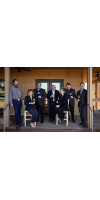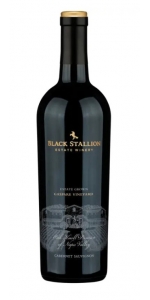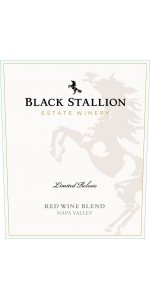Wine from Black Stallion

Twelve years after arriving in America, in 1924, Gaspare Indelicato planted a vineyard in Manteca, California. With it, he planted the foundation of his eventual success in the California wine trade. Since that first vineyard flourished, Gaspare’s children, grandchildren and great-grandchildren have honored his legacy through dedication to his steadfast values of family, hard work and integrity.
More than a century ago, Gaspare and Caterina Indelicato immigrated from Sicily to the United States. With little to draw on but a long family history of grapegrowing and an entreprenuer’s gift for seizing opportunity, Gaspare entered the wine trade by planting a single vineyard in Manteca, California, where the climate reminded the couple of their homeland
Occupying a privileged position at the southern foot of the trail, the winery grounds eventually became the site of the Silverado Western Center, a major equestrian center that opened in September 1963.
The original riding area now houses prized wines, instead of prize-winning horses. However Black Stallion Estate Winery carries its heritage forward. The estate’s legacy honors the world-class terroir of Napa Valley, the pioneering spirit of the Silverado Trail, and the Indelicato family’s warm hospitality and generations of wine expertise.
To make great wine, a winemaker must have a deep familiarity with each lot of freshly pressed juice. At Black Stallion, the search for greatness means boots in the vineyard, checking on vine growth and grape development all year long. It means tasting grapes rather than looking at lab reports to determine the perfect moment to pick. It means harvesting and sorting fruit by hand. Black Stallion Winery’s small scale means that each lot of grapes that arrives at harvest is treated individually, and receives a unique upbringing to bring out its full potential for excellence.
After fermentation, wine is drained using gravity (not pumps) and aged in the finest oak barrels. The gentle handling of the wine prevents the extraction of harsh components that could impart bitterness.
Once crushed at the winery, micro-lots may be fermented in small tanks made of wood, concrete or steel. These choices of aging vessel give winemaker Ralf Holdenried exceptional flexibility to match a batch of grapes with the material best suited to bring out its greatness—key in a region as diverse as Napa Valley.
There’s no set recipe for a Black Stallion blend, just the finely honed palates of winemaker Ralf Holdenried and his team. It’s not uncommon for Holdenried to try dozens of trial blends before deciding on a final cuvée. The goal is always the same: To create a seamless, harmonious wine that captures the varietal’s best expression of that vintage in Napa Valley.
Our 2021 Gaspare Vineyard Cabernet Sauvignon is made from our grapes grown on the BSEW Estate in the Gaspare Vineyard blocks. Our vineyard is located in the Oak Knoll District of Napa Valley, which is known for it’s moderate growing climate which encourages consistent ripening throughout the growing season. Our 2021 vintage exhibits aromas of blackberry, brown sugar and cedar. It has a dark fruit flavor finished by powerful but elegant.
Review:
The 2021 Gaspare Vineyard Cabernet Sauvignon has a deep garnet-purple color. The nose is a little trapped behind the oak at this youthful stage, allowing glimpses and blackcurrant jelly and juicy plums notes with hints of menthol and anise. Full-bodied, the palate similarly sports a good amount of oak, backed up by the seductive black fruits and approachable, grainy tannins, finishing with a spicy kick.
-Wine Independent 93 Point
Black Stallion Napa Valley Limited Release Red.
The winery takes its name from a major equestrian area that once occupied the grounds. Its calling card is Cabernet Sauvignon, made in a classic Napa Valley style that offers richness and finesse. While single-vineyard wines are occasionally bottled, most Black Stallion wines are made from small lots cherry-picked from the valley’s disparate winegrowing zones. These are then painstakingly blended to create luxurious, unforgettable wines that capture the depth and brilliance of Napa Valley’s diverse growing regions.
Review:
This blend is softly layered in dense, rich tones of plum and cherry, with a rounded approachability and well-integrated tannin and oak. Chocolate, leather and clove accent the finish.
-Wine Enthusiast 90 Points
- back
Selected Options
Wineries
Categories
Pricing
Countries
Regions
Grape Types
Wineries
Organic/Free Shipping
Thibaut-Janisson Blanc de Chardonnay is made from 100% Chardonnay
Appellation 100% Virginia
Winemaking Notes The grapes are handpicked in small baskets late August and are gently pressed as whole clusters. After a settling of 24 hours, the juice is inoculated with selected Champagne yeast and ferments in stainless steel tanks at low temperature. Once the fermentation is over, the wine ages on the fine lees until the spring of the following year. The blend is then put together and cold-stabilized prior to bottling. The bottling occurs in the spring when the cellar temperature is conducive to a second fermentation in the bottle. The now sparkling wine will age on the yeast for over 24 months. At disgorging, a small amount of dosage liquor is added in order to balance the natural acidity.
Clean, crisp and refreshing! With scents of white flowers, apples and pears. This sparkling wine is elegant and complex with vibrant aromas, and fine active streamers. The depth of complexity is elegant and the intricate nuances of the terroir fill the nose and stimulate the palate. It’s full of youthful, bright and alert acidity.
Caymus Suisan Grand Durif is made from 100 percent Caymus Suisan Grand Durif.
Only 30 minutes from Napa, Suisun Valley (which became an AVA in 1982) is still largely undiscovered. With its warm days and cool nights, this pastoral region reminds us of Napa Valley in the 1960s. Known for delicious stone fruits and walnuts, it is also gaining recognition for exceptional wine. Durif is synonymous with Petite Sirah, the widely grown grape in the region – we added “Grand” to the name for its grand style. With harmonious tannins, this wine is opulent, luxuriously soft and totally enjoyable.






